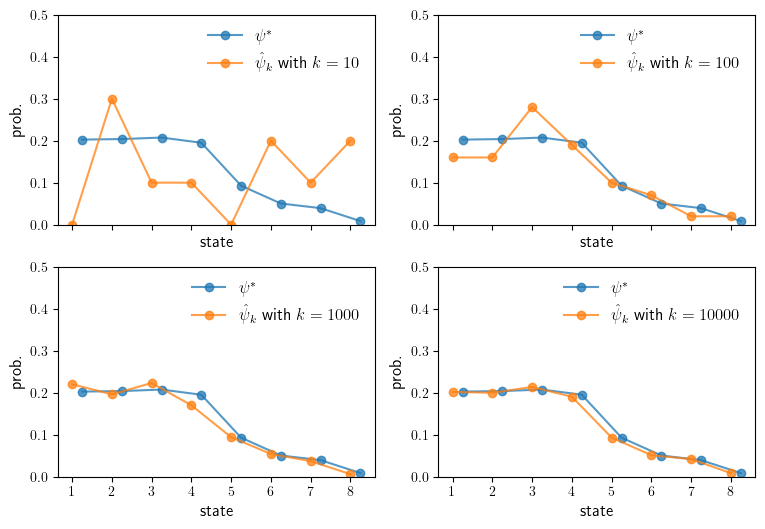Chapter 4 - Markov Chains and Networks (Python Code)#
! pip install --upgrade quantecon_book_networks
Show code cell output
Requirement already satisfied: quantecon_book_networks in /usr/share/miniconda3/envs/networks/lib/python3.11/site-packages (1.1)
Requirement already satisfied: numpy in /usr/share/miniconda3/envs/networks/lib/python3.11/site-packages (from quantecon_book_networks) (1.24.3)
Requirement already satisfied: scipy in /usr/share/miniconda3/envs/networks/lib/python3.11/site-packages (from quantecon_book_networks) (1.11.1)
Requirement already satisfied: pandas in /usr/share/miniconda3/envs/networks/lib/python3.11/site-packages (from quantecon_book_networks) (2.0.3)
Requirement already satisfied: matplotlib in /usr/share/miniconda3/envs/networks/lib/python3.11/site-packages (from quantecon_book_networks) (3.7.2)
Requirement already satisfied: pandas-datareader in /usr/share/miniconda3/envs/networks/lib/python3.11/site-packages (from quantecon_book_networks) (0.10.0)
Requirement already satisfied: networkx in /usr/share/miniconda3/envs/networks/lib/python3.11/site-packages (from quantecon_book_networks) (3.1)
Requirement already satisfied: quantecon in /usr/share/miniconda3/envs/networks/lib/python3.11/site-packages (from quantecon_book_networks) (0.7.1)
Requirement already satisfied: POT in /usr/share/miniconda3/envs/networks/lib/python3.11/site-packages (from quantecon_book_networks) (0.9.3)
Requirement already satisfied: contourpy>=1.0.1 in /usr/share/miniconda3/envs/networks/lib/python3.11/site-packages (from matplotlib->quantecon_book_networks) (1.0.5)
Requirement already satisfied: cycler>=0.10 in /usr/share/miniconda3/envs/networks/lib/python3.11/site-packages (from matplotlib->quantecon_book_networks) (0.11.0)
Requirement already satisfied: fonttools>=4.22.0 in /usr/share/miniconda3/envs/networks/lib/python3.11/site-packages (from matplotlib->quantecon_book_networks) (4.25.0)
Requirement already satisfied: kiwisolver>=1.0.1 in /usr/share/miniconda3/envs/networks/lib/python3.11/site-packages (from matplotlib->quantecon_book_networks) (1.4.4)
Requirement already satisfied: packaging>=20.0 in /usr/share/miniconda3/envs/networks/lib/python3.11/site-packages (from matplotlib->quantecon_book_networks) (23.1)
Requirement already satisfied: pillow>=6.2.0 in /usr/share/miniconda3/envs/networks/lib/python3.11/site-packages (from matplotlib->quantecon_book_networks) (9.4.0)
Requirement already satisfied: pyparsing<3.1,>=2.3.1 in /usr/share/miniconda3/envs/networks/lib/python3.11/site-packages (from matplotlib->quantecon_book_networks) (3.0.9)
Requirement already satisfied: python-dateutil>=2.7 in /usr/share/miniconda3/envs/networks/lib/python3.11/site-packages (from matplotlib->quantecon_book_networks) (2.8.2)
Requirement already satisfied: pytz>=2020.1 in /usr/share/miniconda3/envs/networks/lib/python3.11/site-packages (from pandas->quantecon_book_networks) (2023.3.post1)
Requirement already satisfied: tzdata>=2022.1 in /usr/share/miniconda3/envs/networks/lib/python3.11/site-packages (from pandas->quantecon_book_networks) (2023.3)
Requirement already satisfied: lxml in /usr/share/miniconda3/envs/networks/lib/python3.11/site-packages (from pandas-datareader->quantecon_book_networks) (4.9.3)
Requirement already satisfied: requests>=2.19.0 in /usr/share/miniconda3/envs/networks/lib/python3.11/site-packages (from pandas-datareader->quantecon_book_networks) (2.31.0)
Requirement already satisfied: numba>=0.49.0 in /usr/share/miniconda3/envs/networks/lib/python3.11/site-packages (from quantecon->quantecon_book_networks) (0.57.1)
Requirement already satisfied: sympy in /usr/share/miniconda3/envs/networks/lib/python3.11/site-packages (from quantecon->quantecon_book_networks) (1.11.1)
Requirement already satisfied: llvmlite<0.41,>=0.40.0dev0 in /usr/share/miniconda3/envs/networks/lib/python3.11/site-packages (from numba>=0.49.0->quantecon->quantecon_book_networks) (0.40.0)
Requirement already satisfied: six>=1.5 in /usr/share/miniconda3/envs/networks/lib/python3.11/site-packages (from python-dateutil>=2.7->matplotlib->quantecon_book_networks) (1.16.0)
Requirement already satisfied: charset-normalizer<4,>=2 in /usr/share/miniconda3/envs/networks/lib/python3.11/site-packages (from requests>=2.19.0->pandas-datareader->quantecon_book_networks) (2.0.4)
Requirement already satisfied: idna<4,>=2.5 in /usr/share/miniconda3/envs/networks/lib/python3.11/site-packages (from requests>=2.19.0->pandas-datareader->quantecon_book_networks) (3.4)
Requirement already satisfied: urllib3<3,>=1.21.1 in /usr/share/miniconda3/envs/networks/lib/python3.11/site-packages (from requests>=2.19.0->pandas-datareader->quantecon_book_networks) (1.26.16)
Requirement already satisfied: certifi>=2017.4.17 in /usr/share/miniconda3/envs/networks/lib/python3.11/site-packages (from requests>=2.19.0->pandas-datareader->quantecon_book_networks) (2023.7.22)
Requirement already satisfied: mpmath>=0.19 in /usr/share/miniconda3/envs/networks/lib/python3.11/site-packages (from sympy->quantecon->quantecon_book_networks) (1.3.0)
We begin with some imports.
import quantecon as qe
import quantecon_book_networks
import quantecon_book_networks.input_output as qbn_io
import quantecon_book_networks.plotting as qbn_plt
import quantecon_book_networks.data as qbn_data
ch4_data = qbn_data.markov_chains_and_networks()
export_figures = False
import numpy as np
import pandas as pd
import networkx as nx
import matplotlib.pyplot as plt
from matplotlib import cm
from mpl_toolkits.mplot3d import Axes3D
from mpl_toolkits.mplot3d.art3d import Poly3DCollection
quantecon_book_networks.config("matplotlib")
Example transition matrices#
In this chapter two transition matrices are used.
First, a Markov model is estimated in the international growth dynamics study of Quah (1993).
The state is real GDP per capita in a given country relative to the world average.
Quah discretizes the possible values to 0–1/4, 1/4–1/2, 1/2–1, 1–2 and 2–inf, calling these states 1 to 5 respectively. The transitions are over a one year period.
P_Q = [
[0.97, 0.03, 0, 0, 0 ],
[0.05, 0.92, 0.03, 0, 0 ],
[0, 0.04, 0.92, 0.04, 0 ],
[0, 0, 0.04, 0.94, 0.02],
[0, 0, 0, 0.01, 0.99]
]
P_Q = np.array(P_Q)
codes_Q = ('1', '2', '3', '4', '5')
Second, Benhabib et al. (2015) estimate the following transition matrix for intergenerational social mobility.
The states are percentiles of the wealth distribution.
In particular, states 1, 2,…, 8, correspond to the percentiles 0-20%, 20-40%, 40-60%, 60-80%, 80-90%, 90-95%, 95-99%, 99-100%.
P_B = [
[0.222, 0.222, 0.215, 0.187, 0.081, 0.038, 0.029, 0.006],
[0.221, 0.22, 0.215, 0.188, 0.082, 0.039, 0.029, 0.006],
[0.207, 0.209, 0.21, 0.194, 0.09, 0.046, 0.036, 0.008],
[0.198, 0.201, 0.207, 0.198, 0.095, 0.052, 0.04, 0.009],
[0.175, 0.178, 0.197, 0.207, 0.11, 0.067, 0.054, 0.012],
[0.182, 0.184, 0.2, 0.205, 0.106, 0.062, 0.05, 0.011],
[0.123, 0.125, 0.166, 0.216, 0.141, 0.114, 0.094, 0.021],
[0.084, 0.084, 0.142, 0.228, 0.17, 0.143, 0.121, 0.028]
]
P_B = np.array(P_B)
codes_B = ('1', '2', '3', '4', '5', '6', '7', '8')
Markov Chains as Digraphs#
Contour plot of a transition matrix#
Here we define a function for producing contour plots of matrices.
def plot_matrices(matrix,
codes,
ax,
font_size=12,
alpha=0.6,
colormap=cm.viridis,
color45d=None,
xlabel='sector $j$',
ylabel='sector $i$'):
ticks = range(len(matrix))
levels = np.sqrt(np.linspace(0, 0.75, 100))
if color45d != None:
co = ax.contourf(ticks,
ticks,
matrix,
alpha=alpha, cmap=colormap)
ax.plot(ticks, ticks, color=color45d)
else:
co = ax.contourf(ticks,
ticks,
matrix,
levels,
alpha=alpha, cmap=colormap)
ax.set_xlabel(xlabel, fontsize=font_size)
ax.set_ylabel(ylabel, fontsize=font_size)
ax.set_yticks(ticks)
ax.set_yticklabels(codes_B)
ax.set_xticks(ticks)
ax.set_xticklabels(codes_B)
Now we use our function to produce a plot of the transition matrix for intergenerational social mobility, \(P_B\).
fig, ax = plt.subplots(figsize=(6,6))
plot_matrices(P_B.transpose(), codes_B, ax, alpha=0.75,
colormap=cm.viridis, color45d='black',
xlabel='state at time $t$', ylabel='state at time $t+1$')
if export_figures:
plt.savefig("figures/markov_matrix_visualization.pdf")
plt.show()
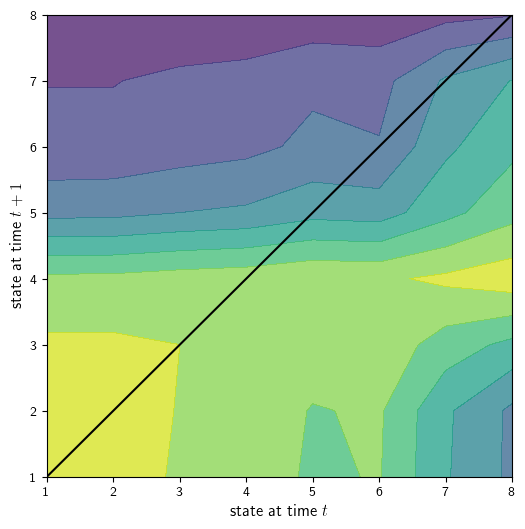
Wealth percentile over time#
Here we compare the mixing of the transition matrix for intergenerational social mobility \(P_B\) and the transition matrix for international growth dynamics \(P_Q\).
We begin by creating quantecon MarkovChain objects with each of our transition
matrices.
mc_B = qe.MarkovChain(P_B, state_values=range(1, 9))
mc_Q = qe.MarkovChain(P_Q, state_values=range(1, 6))
Next we define a function to plot simulations of Markov chains.
Two simulations will be run for each MarkovChain, one starting at the
minimum initial value and one at the maximum.
def sim_fig(ax, mc, T=100, seed=14, title=None):
X1 = mc.simulate(T, init=1, random_state=seed)
X2 = mc.simulate(T, init=max(mc.state_values), random_state=seed+1)
ax.plot(X1)
ax.plot(X2)
ax.set_xlabel("time")
ax.set_ylabel("state")
ax.set_title(title, fontsize=12)
Finally, we produce the figure.
fig, axes = plt.subplots(2, 1, figsize=(6, 4))
ax = axes[0]
sim_fig(axes[0], mc_B, title="$P_B$")
sim_fig(axes[1], mc_Q, title="$P_Q$")
axes[1].set_yticks((1, 2, 3, 4, 5))
plt.tight_layout()
if export_figures:
plt.savefig("figures/benhabib_mobility_mixing.pdf")
plt.show()
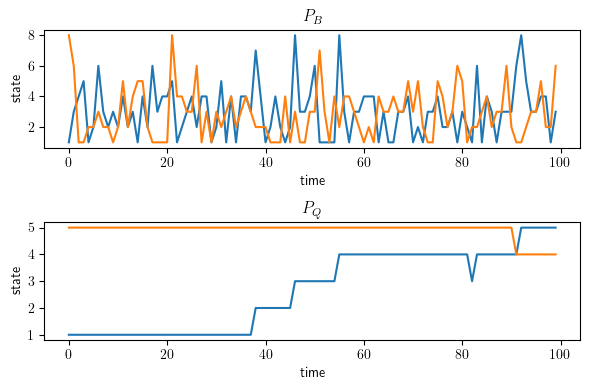
Predicted vs realized cross-country income distributions for 2019#
Here we load a pandas DataFrame of GDP per capita data for countries compared to the global average.
gdppc_df = ch4_data['gdppc_df']
gdppc_df.head()
| gdppc | gdppc_w | gdppc_r | ||
|---|---|---|---|---|
| country | year | |||
| Aruba | 2019 | 31902.809818 | 11338.150319 | 2.813758 |
| Afghanistan | 2019 | 497.741429 | 11338.150319 | 0.043900 |
| Angola | 2019 | 2191.347764 | 11338.150319 | 0.193272 |
| Albania | 2019 | 5396.214243 | 11338.150319 | 0.475934 |
| Andorra | 2019 | 41328.612393 | 11338.150319 | 3.645093 |
Now we assign countries bins, as per Quah (1993).
q = [0, 0.25, 0.5, 1.0, 2.0, np.inf]
l = [0, 1, 2, 3, 4]
x = pd.cut(gdppc_df.gdppc_r, bins=q, labels=l)
gdppc_df['interval'] = x
gdppc_df = gdppc_df.reset_index()
gdppc_df['interval'] = gdppc_df['interval'].astype(float)
gdppc_df['year'] = gdppc_df['year'].astype(float)
Here we define a function for calculating the cross-country income distributions for a given date range.
def gdp_dist_estimate(df, l, yr=(1960, 2019)):
Y = np.zeros(len(l))
for i in l:
Y[i] = df[
(df['interval'] == i) &
(df['year'] <= yr[1]) &
(df['year'] >= yr[0])
].count()[0]
return Y / Y.sum()
We calculate the true distribution for 1985.
ψ_1985 = gdp_dist_estimate(gdppc_df,l,yr=(1985, 1985))
Now we use the transition matrix to update the 1985 distribution \(t = 2019 - 1985 = 34\) times to get our predicted 2019 distribution.
ψ_2019_predicted = ψ_1985 @ np.linalg.matrix_power(P_Q, 2019-1985)
Now, calculate the true 2019 distribution.
ψ_2019 = gdp_dist_estimate(gdppc_df,l,yr=(2019, 2019))
Finally we produce the plot.
states = np.arange(0, 5)
ticks = range(5)
codes_S = ('1', '2', '3', '4', '5')
fig, ax = plt.subplots(figsize=(6, 4))
width = 0.4
ax.plot(states, ψ_2019_predicted, '-o', alpha=0.7, label='predicted')
ax.plot(states, ψ_2019, '-o', alpha=0.7, label='realized')
ax.set_xlabel("state")
ax.set_ylabel("probability")
ax.set_yticks((0.15, 0.2, 0.25, 0.3))
ax.set_xticks(ticks)
ax.set_xticklabels(codes_S)
ax.legend(loc='upper center', fontsize=12)
if export_figures:
plt.savefig("figures/quah_gdppc_prediction.pdf")
plt.show()
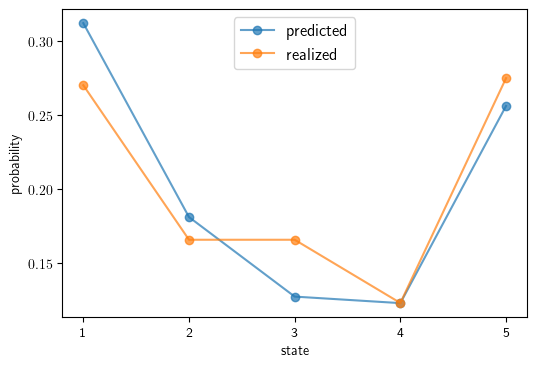
Distribution dynamics#
Here we define a function for plotting the convergence of marginal distributions \(\psi\) under a transition matrix \(P\) on the unit simplex.
def convergence_plot(ψ, P, n=14, angle=50):
ax = qbn_plt.unit_simplex(angle)
# Convergence plot
P = np.array(P)
ψ = ψ # Initial condition
x_vals, y_vals, z_vals = [], [], []
for t in range(n):
x_vals.append(ψ[0])
y_vals.append(ψ[1])
z_vals.append(ψ[2])
ψ = ψ @ P
ax.scatter(x_vals, y_vals, z_vals, c='darkred', s=80, alpha=0.7, depthshade=False)
mc = qe.MarkovChain(P)
ψ_star = mc.stationary_distributions[0]
ax.scatter(ψ_star[0], ψ_star[1], ψ_star[2], c='k', s=80)
return ψ
Now we define P.
P = (
(0.9, 0.1, 0.0),
(0.4, 0.4, 0.2),
(0.1, 0.1, 0.8)
)
A trajectory from \(\psi_0 = (0, 0, 1)\)#
Here we see the sequence of marginals appears to converge.
ψ_0 = (0, 0, 1)
ψ = convergence_plot(ψ_0, P)
if export_figures:
plt.savefig("figures/simplex_2.pdf")
plt.show()
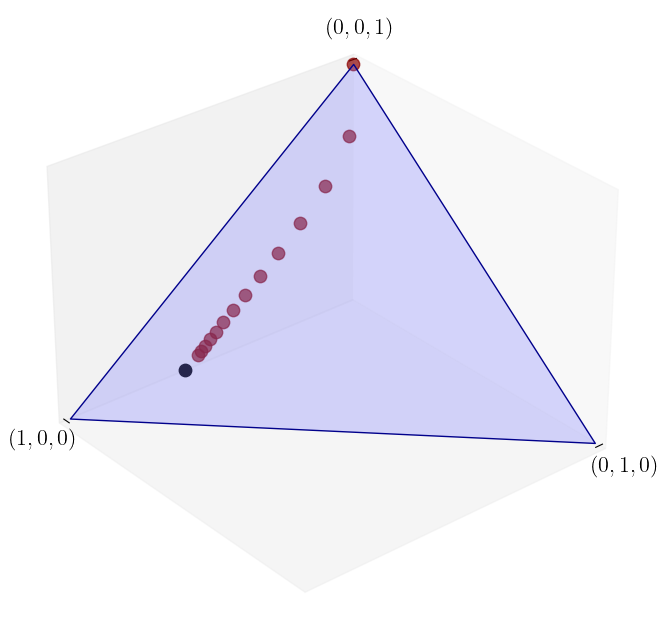
A trajectory from \(\psi_0 = (0, 1/2, 1/2)\)#
Here we see again that the sequence of marginals appears to converge, and the limit appears not to depend on the initial distribution.
ψ_0 = (0, 1/2, 1/2)
ψ = convergence_plot(ψ_0, P, n=12)
if export_figures:
plt.savefig("figures/simplex_3.pdf")
plt.show()
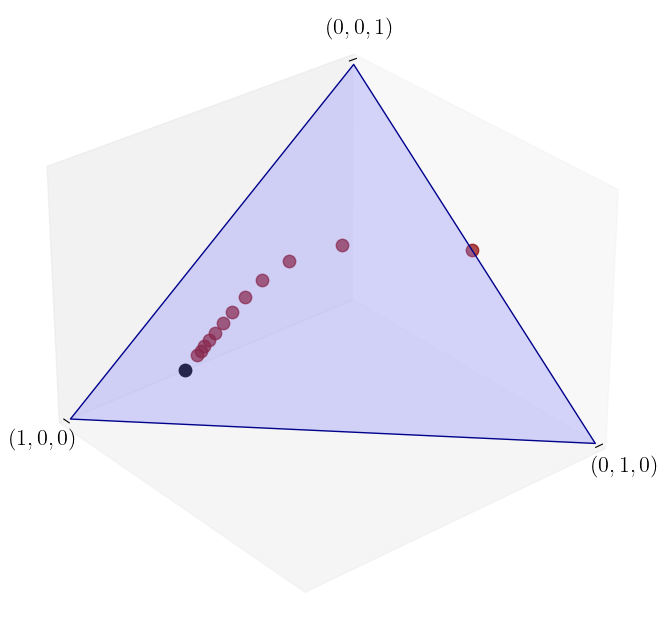
Distribution projections from \(P_B\)#
Here we define a function for plotting \(\psi\) after \(n\) iterations of the transition matrix \(P\). The distribution \(\psi_0\) is taken as the uniform distribution over the state space.
def transition(P, n, ax=None):
P = np.array(P)
nstates = P.shape[1]
s0 = np.ones(8) * 1/nstates
s = s0
for i in range(n):
s = s @ P
if ax is None:
fig, ax = plt.subplots()
ax.plot(range(1, nstates+1), s, '-o', alpha=0.6)
ax.set(ylim=(0, 0.25),
xticks=((1, nstates)))
ax.set_title(f"$t = {n}$")
return ax
We now generate the marginal distributions after 0, 1, 2, and 100 iterations for \(P_B\).
ns = (0, 1, 2, 100)
fig, axes = plt.subplots(1, len(ns), figsize=(6, 4))
for n, ax in zip(ns, axes):
ax = transition(P_B, n, ax=ax)
ax.set_xlabel("Quantile")
plt.tight_layout()
if export_figures:
plt.savefig("figures/benhabib_mobility_dists.pdf")
plt.show()
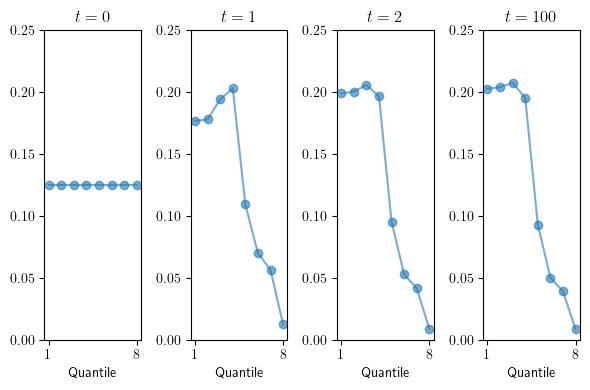
Asymptotics#
Convergence of the empirical distribution to \(\psi^*\)#
We begin by creating a MarkovChain object, taking \(P_B\) as the transition matrix.
mc = qe.MarkovChain(P_B)
Next we use the quantecon package to calculate the true stationary distribution.
stationary = mc.stationary_distributions[0]
n = len(mc.P)
Now we define a function to simulate the Markov chain.
def simulate_distribution(mc, T=100):
# Simulate path
n = len(mc.P)
path = mc.simulate_indices(ts_length=T, random_state=1)
distribution = np.empty(n)
for i in range(n):
distribution[i] = np.mean(path==i)
return distribution
We run simulations of length 10, 100, 1,000 and 10,000.
lengths = [10, 100, 1_000, 10_000]
dists = []
for t in lengths:
dists.append(simulate_distribution(mc, t))
Now we produce the plots.
We see that the simulated distribution starts to approach the true stationary distribution.
fig, axes = plt.subplots(2, 2, figsize=(9, 6), sharex='all')#, sharey='all')
axes = axes.flatten()
for dist, ax, t in zip(dists, axes, lengths):
ax.plot(np.arange(n)+1 + .25,
stationary,
'-o',
#width = 0.25,
label='$\\psi^*$',
alpha=0.75)
ax.plot(np.arange(n)+1,
dist,
'-o',
#width = 0.25,
label=f'$\\hat \\psi_k$ with $k={t}$',
alpha=0.75)
ax.set_xlabel("state", fontsize=12)
ax.set_ylabel("prob.", fontsize=12)
ax.set_xticks(np.arange(n)+1)
ax.legend(loc='upper right', fontsize=12, frameon=False)
ax.set_ylim(0, 0.5)
if export_figures:
plt.savefig("figures/benhabib_ergodicity_1.pdf")
plt.show()
